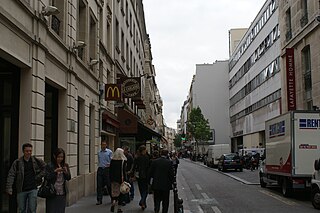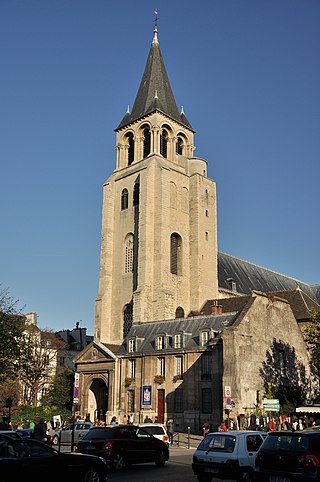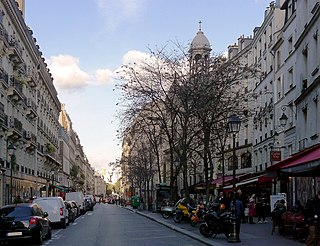
Hector Guimard was a French architect and designer, and a prominent figure of the Art Nouveau style. He achieved early fame with his design for the Castel Beranger, the first Art Nouveau apartment building in Paris, which was selected in an 1899 competition as one of the best new building facades in the city. He is best known for the glass and iron edicules or canopies, with ornamental Art Nouveau curves, which he designed to cover the entrances of the first stations of the Paris Metro.

Magenta station is a station of the Île-de-France Réseau Express Régional (RER), in the 10th arrondissement of Paris, France. Built on the site of the Gare du Nord, the original name of Magenta station was Nord-Est with the possibility of a connection to both Paris-Nord and Paris-Est.

The Rue de l'Abbaye is a residential street in the 6th arrondissement of Paris, named after the Abbey of Saint-Germain-des-Prés. It has a length of some 170 m and runs from the Rue Guillaume Apollinaire to the Rue de l'Echaudé. The street itself dates from 1800, although the land it runs over has a much longer history. The oldest and most prominent buildings on the street are the abbey's side entrance and former abbot's residence, built in 1586. It now is the home of the Catholic Institute of France.

This "quartier" of Paris got its name from the rue de la Chaussée-d'Antin in the 9th arrondissement of Paris. It runs north-northwest from the Boulevard des Italiens to the Église de la Sainte-Trinité.

The Rue Saint-Honoré is a street in the 1st arrondissement of Paris, France. It is named after the collegial Saint-Honoré church, situated in ancient times within the cloisters of Saint-Honoré.

The Boulevards of the Marshals are a collection of thoroughfares that encircle the city of Paris, France, just inside its city limits. Most bear the name of a marshal of the First French Empire (1804–1814) who served under Napoleon I. The Île-de-France tramway Lines 3a and 3b today run on the Boulevards of the Marshals.

Jules Aimé Lavirotte was a French architect who is best known for the Art Nouveau buildings he created in the 7th arrondissement in Paris. His buildings were known for his imaginative and exuberant decoration, and particularly for his use of sculpture and glazed ceramic tiles on the facades, made in collaboration with leading sculptors and the ceramic manufacturer Alexandre Bigot. He was three times awarded prizes by the city of Paris for the most original facades, for the Lavirotte Building at 29 Avenue Rapp (1901), for the Ceramic hotel, 34 Avenue de Wagram (1904), and for the building at 23 avenue de Messine in 1907.

Henri Sauvage was a French architect and designer in the early 20th century. He was one of the most important architects in the French Art Nouveau movement, Art Deco, and the beginning of architectural modernism. He was also a pioneer in the construction of public housing buildings in Paris. His major works include the art nouveau Villa Majorelle in Nancy, France and the art-deco building of the La Samaritaine department store in Paris.

The rue de Provence is a street located in the 8th and 9th Arrondissements of Paris. It begins at the rue du Faubourg Montmartre and ends at the rue de Rome. Only the short part of the street between rue du Havre and rue de Rome is in the 8th arrondissement.

The Rue de la République is a street located in the 1st and 2nd arrondissements of Lyon, France. It links the Place de la Comédie in the north to Place Le Viste in the south, just next to Place Bellecour, via the Place de la République.

The Rue Bonaparte is a street in the 6th arrondissement of Paris. It spans the Quai Voltaire/Quai Malaquais to the Jardin du Luxembourg, crossing the Place Saint-Germain-des-Prés and the Place Saint-Sulpice and has housed many of France's most famous names and institutions as well as other well-known figures from abroad.

The Rue Saint-Lazare is a street in the 8th and 9th arrondissements of Paris, France. It starts at 9 Rue Bourdaloue and 1 Rue Notre-Dame-de-Lorette, and ends at Place Gabriel-Péri and Rue de Rome.

The city of Paris has notable examples of architecture of every period, from the Middle Ages to the 21st century. It was the birthplace of the Gothic style, and has important monuments of the French Renaissance, Classical revival, the Flamboyant style of the reign of Napoleon III, the Belle Époque, and the Art Nouveau style. The great Exposition Universelle (1889) and 1900 added Paris landmarks, including the Eiffel Tower and Grand Palais. In the 20th century, the Art Deco style of architecture first appeared in Paris, and Paris architects also influenced the postmodern architecture of the second half of the century.

Frantz Jourdain was a Belgian architect and author. He is best known for La Samaritaine, an Art Nouveau department store built in the 1st arrondissement of Paris in three stages between 1904 and 1928. He was respected as an authority on Art Nouveau.

Paris in the Belle Époque was a period in the history of the city during the years 1871 to 1914, from the beginning of the Third French Republic until the First World War. It saw the construction of the Eiffel Tower, the Paris Métro, the completion of the Paris Opera, and the beginning of the Basilica of Sacré-Cœur on Montmartre. Three lavish "universal expositions" in 1878, 1889, and 1900 brought millions of visitors to Paris to sample the latest innovations in commerce, art, and technology. Paris was the scene of the first public projection of a motion picture, and the birthplace of the Ballets Russes, Impressionism, and Modern Art.

The architecture of Paris created during the Belle Époque, between 1871 and the beginning of the First World War in 1914, was notable for its variety of different styles, from neo-Byzantine and neo-Gothic to classicism, Art Nouveau and Art Deco. It was also known for its lavish decoration and its imaginative use of both new and traditional materials, including iron, plate glass, colored tile and reinforced concrete. Notable buildings and structures of the period include the Eiffel Tower, the Grand Palais, the Théâtre des Champs-Élysées, the Gare de Lyon, the Bon Marché department store, and the entries of the stations of the Paris Metro designed by Hector Guimard.
The authorities of medieval Paris attempted to confine prostitution to a particular district. Louis IX (1226–1270) designated nine streets in the Beaubourg Quartier where it would be permitted. In the early part of the 19th century, state-controlled legal brothels started to appear in several French cities. By law, they had to be run by a woman, and their external appearance had to be discreet. The maisons were required to light a red lantern when they were open, and the prostitutes were only permitted to leave the maisons on certain days and only if accompanied by its head. By 1810, Paris alone had 180 officially approved brothels.
Located at 106, rue du Faubourg-Poissonnière in the 10th arrondissement of Paris, Rocroy Saint-Vincent de Paul is a mixed private Catholic school under contract of association with the State.

La Fermette Marbeuf was a prestigious gourmet restaurant in the Champs-Élysées quarter in the 8th arrondissement of Paris, France. Its Belle Époque Art Nouveau "1900 room" has been an official Historical Monument since 1983. It now hosts the restaurant Beefbar.

The Rue des Archives is a street in Le Marais at the border of 3rd and 4th arrondissements of Paris, France.



















